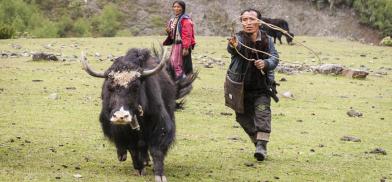COVID, bear attacks take a toll on Bhutan's yak herders
Hundreds of yak herders in the remote mountains of Bhutan are facing a tough time due to COVID-19

Hundreds of yak herders in the remote mountains of Bhutan are facing a tough time due to COVID-19. As the government has imposed travel restrictions across the country, yak herders are not able to sell their butter and dried cheese, which now stays stacked up in their huts.
Apart from not being able to sell their produce, they are not able to buy essential items because of escalating prices of food items.
At Tsento Gewog in Paro town, the herders were forced to slaughter nearly 45 yaks and sold the meat for survival. In Dhur Chiwog of Bumthang Dzongkhag where there are about seventeen households of yak herders, life has become equally difficult.
Dorji, a resident of Dhur in Bumthang said: “The dairy products get sold only when there are unrestricted movements ... But it has been a year of lockdowns and travel restrictions and moreover, as our products are not essential food items, it is becoming increasingly difficult for us to sell them.
“In contrast, the price for imported goods such as rice, cooking oil, and vegetables have either doubled or tripled over the last one-year or so. If the pandemic is not contained soon enough, it would become very difficult for us to sustain our livelihoods,” he was quoted by The Bhutanese Expression.
“Rice, vegetable and chili prices have increased steeply after the pandemic hit the country. But prices of yaks’ dairy products have remained the same. So the situation has become harsh for yak herders like me. In the past, the sale of cordyceps (unique and exotic mushrooms) used to be an alternative source of income but due to the economic distress caused by the pandemic, we didn’t fetch good prices for cordyceps this year,” added Tawla, another resident of Dhur.
In Dhur in central Bhutan, the practice of yak herding has remained largely unaffected by modernization. However, some of the herders fear that the practice could go down if the pandemic situation does not improve.
“If the pandemic situation doesn’t improve for few more years and dairy products continue to remain unsold, I think people will consider giving up yak herding,” said Dorji.
Officials at the National Highland Research and Development Centre (NHRDC) in Bumthang said yak herders’ groups should inform the centre for intervention. The centre has trained yak herders in product diversification. One such training was conducted in Haa last year and another in Wangduephodrang last week. The centre plans to conduct similar training in all yak-rearing districts.
According to Dr. Vijay Raika, the program director of the Centre, “Under the highland development program, we are trying to diversify dairy products in a modern way that includes value chain, packaging and in fact, we are also trying to see the nutritional contents in the diversified products.
"For example, some of the products where the herders were trained were making Rasgula, ghee and we are also looking into packaging, labeling, and certification aspects. Unless we diversify the yak products, the market issue will always be there,” he was quoted by the newspaper.
In addition to the marketing issues faced this year, yak herders have also been confronting bear attacks on their ration stores for several years now. Yak herders build a separate shelter by stacking stones to keep their ration safe.
This is done due to difficulties in transporting the goods in the steep and rough terrains. As they keep moving from one place to another throughout the year, they use the store as a food-supply base. However, bears often damage the structures.
The yak herders said that the attacks by bears at their rations are something that they had not seen earlier.
“Traditionally, bears don’t raid our ration huts. So, this is a fairly new issue. It’s been about five to six years now since such an issue was first reported. We have to guard our rations every night or else we would lose them to bears. The animals eat whatever they can and damage the rest.”
Authorities had offered to provide them with solar-fencing for enclosing the huts but they are still waiting for it.
“It would be very beneficial for us if the government could help us in constructing concrete structures to store our provisions,” added Dorji.
“This is a very serious issue. We can’t keep guarding the ration stores all the time, as we have to move and settle in other locations with yaks. This is especially difficult for herders who don’t have any helper with them. As most children go to school these days, some of the herders stay alone in the mountains. That’s why our ration stores get attacked by bears often,” added Tawla.
The NHRDC is planning to propose a separate budget to address the issue.
“Actually the highland development program mainly looks after the products, packaging and value addition, so it doesn’t cover the construction works and infrastructure development of yak herders. But again we have seen that these are some of the issues not only in Bumthang but most of the highland areas, so now we are in the process of proposing a separate proposal whereby we can assist them in these areas,” added Dr. Raika.
With yaks about to move back to higher grazing grounds in about a month’s time, yak herders are hoping that the authorities act fast to address both the marketing and bear menace issues – otherwise, survival for them would be difficult.









Post a Comment